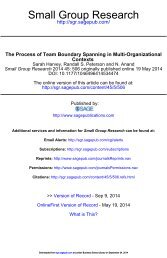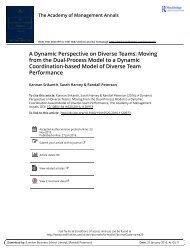Group Dynamics in Top Management Teams: Groupthink, Vigilance, and Alternative Models of Organizational Failure and Success
This study explored the heuristic value of Janis’ (1982) groupthink and vigilant decision making models as explanations of failure and success in top management team decision making using the Organizational Group Dynamics Q-sort (GDQ). Top management teams of seven Fortune 500 companies were examined at two historical junctures—one when the team was successful (defined as satisfying strategic constituencies) and one when the team was unsuccessful. Results strongly supported the notion that a group’s decision making process is systematically related to the outcomes experienced by the team. Ideal-type Q-sorts organized around Janis’ analysis of groupthink and vigilance were substantially correlated with Q-sorts of failing and successful groups, respectively. The fit was, however, far from perfect. Ideal type Q-sorts derived from other frameworks correlated better with the failure–success classification than did the Janis-derived ideal types. Successful groups showed some indicators of groupthink (e.g., risk-taking, cohesion, and strong, opinionated leaders), whereas unsuccessful groups showed signs of vigilance (e.g., internal debate to the point of factionalism). The results illustrate the usefulness of the GDQ for developing and empirically testing theory in organizational behavior from historical cases.
This study explored the heuristic value of Janis’ (1982) groupthink
and vigilant decision making models as explanations of
failure and success in top management team decision making
using the Organizational Group Dynamics Q-sort (GDQ). Top
management teams of seven Fortune 500 companies were examined
at two historical junctures—one when the team was successful
(defined as satisfying strategic constituencies) and one when the team was unsuccessful. Results strongly supported the notion
that a group’s decision making process is systematically related
to the outcomes experienced by the team. Ideal-type Q-sorts organized
around Janis’ analysis of groupthink and vigilance were
substantially correlated with Q-sorts of failing and successful
groups, respectively. The fit was, however, far from perfect. Ideal type
Q-sorts derived from other frameworks correlated better
with the failure–success classification than did the Janis-derived
ideal types. Successful groups showed some indicators of groupthink
(e.g., risk-taking, cohesion, and strong, opinionated leaders),
whereas unsuccessful groups showed signs of vigilance (e.g.,
internal debate to the point of factionalism). The results illustrate
the usefulness of the GDQ for developing and empirically testing
theory in organizational behavior from historical cases.
- No tags were found...
Create successful ePaper yourself
Turn your PDF publications into a flip-book with our unique Google optimized e-Paper software.
304 PETERSON ET AL.<br />
George, A. L. (1980). Presidential decision-mak<strong>in</strong>g <strong>in</strong> foreign policy: The effective use <strong>of</strong> <strong>in</strong>formation<br />
<strong>and</strong> advice. Boulder, CO: Westview.<br />
Hensley, T. R., & Griffen, G. W. (1986). Victims <strong>of</strong> groupth<strong>in</strong>k: The Kent State University board<br />
<strong>of</strong> trustees <strong>and</strong> the 1977 gymnasium controversy. Journal <strong>of</strong> Conflict Resolution, 30, 497–531.<br />
Herek, G., Janis, I. L., & Huth, P. (1987). Decision mak<strong>in</strong>g dur<strong>in</strong>g <strong>in</strong>ternational crises: Is quality<br />
<strong>of</strong> process related to outcome? Journal <strong>of</strong> Conflict Resolution, 31, 203–226.<br />
Huseman, R. C., & Driver, R. W. (1979). <strong>Group</strong>th<strong>in</strong>k: Implications for small group decision mak<strong>in</strong>g<br />
<strong>in</strong> bus<strong>in</strong>ess’. In R. Huseman, & A. Carroll (Eds.), Read<strong>in</strong>gs <strong>in</strong> organizational behavior (pp.<br />
100–110). Boston: Allyn <strong>and</strong> Bacon.<br />
Ingrassia, P., & White, J. B. (1994). Comeback. New York: Simon & Schuster.<br />
Janis, I. L. (1972). Victims <strong>of</strong> groupth<strong>in</strong>k. Boston: Houghton Miffl<strong>in</strong>.<br />
Janis, I. L. (1982). Victims <strong>of</strong> groupth<strong>in</strong>k (2nd ed). Boston: Houghton-Miffl<strong>in</strong>.<br />
Janis, I. L. (1985). Sources <strong>of</strong> error <strong>in</strong> strategic decision mak<strong>in</strong>g. In J. M. Penn<strong>in</strong>gs (Ed.), <strong>Organizational</strong><br />
strategy <strong>and</strong> change (pp. 157–197). San Francisco: Jossey-Bass.<br />
Janis, I. L. (1989). Crucial decisions: Leadership <strong>in</strong> policy-mak<strong>in</strong>g <strong>and</strong> management. New York:<br />
Free Press.<br />
Janis, I. L., & Mann, L. (1977). Decision mak<strong>in</strong>g: A psychological analysis <strong>of</strong> conflict, choice <strong>and</strong><br />
commitment. New York: Free Press.<br />
Janis, I. L., & Mann, L. (1992). Cognitive complexity <strong>in</strong> <strong>in</strong>ternational decision mak<strong>in</strong>g. In P. Suedfeld<br />
<strong>and</strong> P. E. Tetlock (Eds.), Psychology <strong>and</strong> social policy (pp. 33–50). Wash<strong>in</strong>gton, DC: Hemisphere.<br />
Joyce, E. (1988). Prime times, bad times. New York: Doubleday.<br />
Kimberly, J. R., & Miles, R. H. (1980). The organizational life cycle: New perspectives for organizational<br />
theory <strong>and</strong> research. San Francisco: Jossey-Bass.<br />
Lager, F. (1994). Ben & Jerry’s: The <strong>in</strong>side scoop. New York: Crown.<br />
L<strong>in</strong>dblom, C. E. (1980). The policy-mak<strong>in</strong>g process (2nd ed). Englewood Cliffs, NJ: Prentice-Hall.<br />
Longley, J., & Pruitt, D. G. (1980). <strong>Group</strong>th<strong>in</strong>k: A critique <strong>of</strong> Janis’ theory. Review <strong>of</strong> Personality<br />
<strong>and</strong> Social Psychology, 1, 74–93.<br />
Manz, C. C., & Sims, H. P., Jr., The potential for “groupth<strong>in</strong>k” <strong>in</strong> autonomous work groups. Human<br />
Relations, 35, 773–784.<br />
McCauley, C. (1989). The nature <strong>of</strong> social <strong>in</strong>fluence <strong>in</strong> groupth<strong>in</strong>k: Compliance <strong>and</strong> <strong>in</strong>ternalization.<br />
Journal <strong>of</strong> Personality <strong>and</strong> Social Psychology, 57, 250–260.<br />
Park, W. (1990). A review <strong>of</strong> the research on groupth<strong>in</strong>k. Journal <strong>of</strong> Behavioral Decision Mak<strong>in</strong>g,<br />
3, 229–245.<br />
Payne, J. W., Bettman, J. R., & Johnson, E. J. (1992). The adaptive decision maker. New York:<br />
Cambridge Univ. Press.<br />
Pendergrast, M. (1993). For God, country, <strong>and</strong> Coca-Cola. New York: Macmillan.<br />
Peterson, R. S. (June 1997). <strong>Group</strong> decision mak<strong>in</strong>g at the top <strong>of</strong> the organization: The case aga<strong>in</strong>st<br />
impartial leadership. Paper presented at the Midwestern Psychological Association, Chicago, IL.<br />
Peterson, R. S. (1997). A directive leadership style <strong>in</strong> group decision mak<strong>in</strong>g can be both virtue<br />
<strong>and</strong> vice: Evidence from elite <strong>and</strong> experimental groups. Journal <strong>of</strong> Personality <strong>and</strong> Social Psychology,<br />
72, 1107–1121.<br />
Pfeffer, J. (1992). Manag<strong>in</strong>g with power: Politics <strong>and</strong> <strong>in</strong>fluence <strong>in</strong> organizations. Boston: Harvard<br />
Bus<strong>in</strong>ess School.<br />
Pfeffer, J., & Moore, W. L. (1980). Power <strong>in</strong> university budget<strong>in</strong>g: A replication <strong>and</strong> extension.<br />
Adm<strong>in</strong>istrative Science Quarterly, 25, 637–653.<br />
Pfeffer, J., & Salancik, G. R. (1974). <strong>Organizational</strong> decision mak<strong>in</strong>g as a political process: The<br />
case <strong>of</strong> a university budget. Adm<strong>in</strong>istrative Science Quarterly, 19, 135–151.<br />
Pfeffer, J., & Salancik, G. R. (1978). The external control or organizations: A resource dependence<br />
perspective. New York: Harper & Row.

















